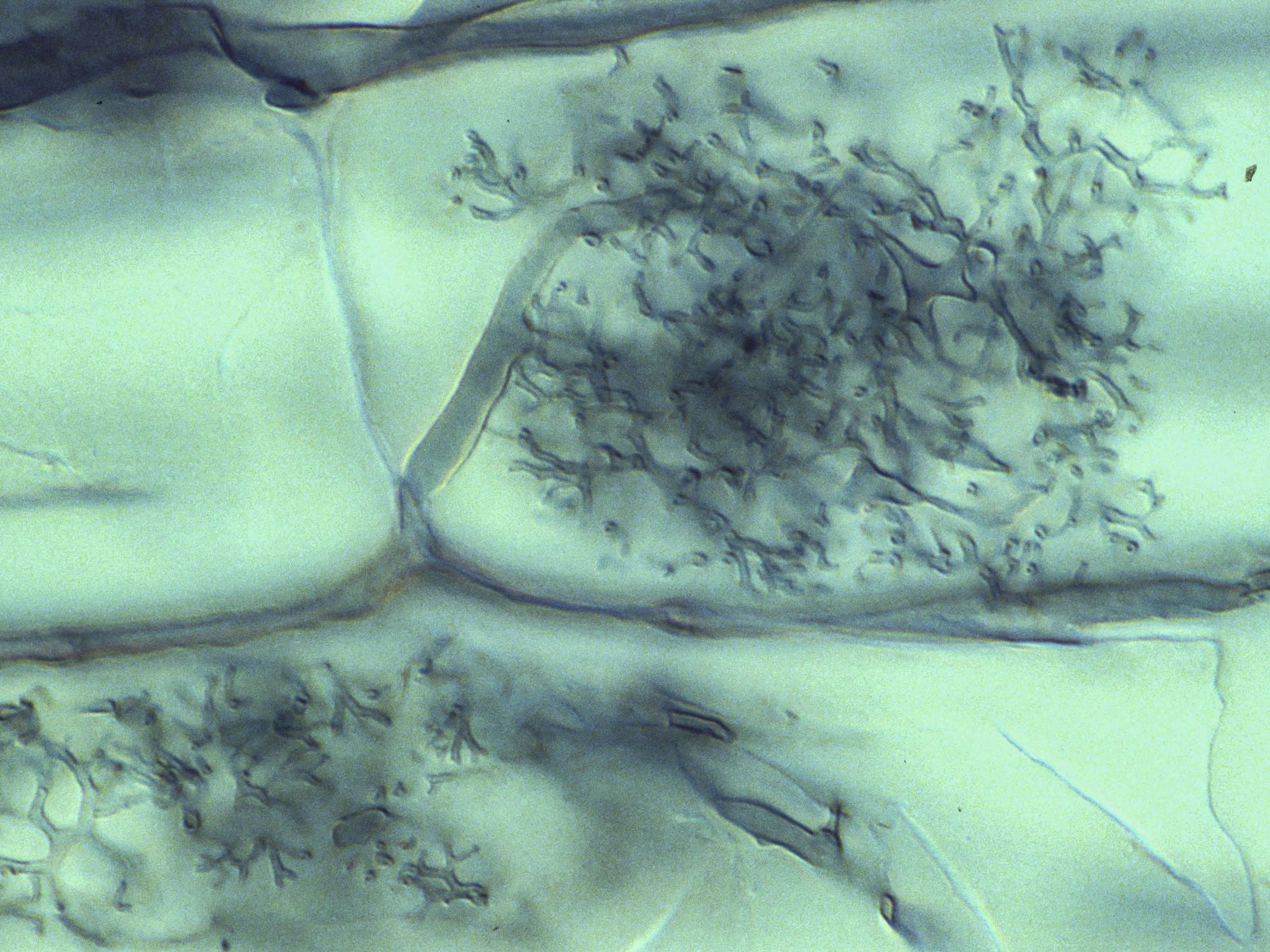Lynette Abbott from The University of Western Australia, focuses on soil health again, this time examining the role of arbuscular mycorrhizas
Mycorrhizas are common associations between plants and highly specialised fungi that participate in important soil health processes, including nutrient uptake by plants. This can include nutrients from fertilisers, the breakdown of soil organic matter, and soil minerals.
Arbuscular mycorrhizal (AM) fungi form extensive networks of hyphae in soil that extend around roots and increase the soil volume that can be explored. In addition to nutrient scavenging, the hyphae contribute to maintaining a friable soil structure that benefits root growth and even helps plants access water in tiny soil pores when soil conditions are dry. Mycorrhizas may also contribute to protection against root disease.

Universal presence of arbuscular mycorrhizas in agricultural soils
Fungi that form mycorrhizal associations are present in all soils. There are several kinds of mycorrhizas, but in agricultural soils, arbuscular mycorrhizas are the most common. These highly specialised plant-microbe associations are formed by fungi that depend on roots to complete their life cycles, which can include sporulation in soil. The fungi have co-evolved with plants over millions of years but cannot be easily cultured as an inoculant in artificial conditions for use in agriculture.
Most agricultural plants form arbuscular mycorrhizas, but there are a few notable exceptions, such as members of the brassica family. Roots are simultaneously colonised by several species of AM fungi, which may compete with each other for carbon from the plant. There is little evidence of specific fungi being required for specific plants as occurs for the root nodule bacteria that form associations with legumes. Some AM fungi are better able to colonise plants than others. The relative abundance of different AM fungi within roots also depends on soil conditions, root growth patterns and characteristics of the fungi themselves, such as the rapidity of spore germination and hyphal growth in and surrounding roots.
When hyphae of AM fungi intercept a root as it grows through soil, the fungus enters with no major alteration to the root surface. In general, the more mycorrhizal hyphae there are in the soil, the greater the extent of root colonisation and vice versa.
AM fungi can survive for long periods as spores or as hyphal fragments in dead roots, even when the soil is dry. Most species’ spores are large, have relatively thick walls resistant to desiccation and are not easily eaten or damaged by other soil organisms. Several AM fungi have been shown to have interesting associations with bacteria. Spores of some AM fungi have a dormant phase, germinating only when soil conditions become suitable.

Arbuscular mycorrhizas and soil health
AM fungi have a wide range of soil health benefits associated with plant nutrition, plant access to water and the stabilisation of soil particles into aggregates that improve physical soil conditions for root growth and soil security more generally.
AM fungi can exchange plant carbohydrates for phosphorus, a nutrient that does not move easily in the soil solution, as nitrogen does. The supply of other plant nutrients, such as copper and zinc, may also be improved via soil exploration by the soil hyphal network of AM fungi.
Plant root architecture influences the capacity of AM fungi to benefit plant nutrition in nutrient-deficient soil. Plants with fibrous root systems, like grasses, which can thoroughly explore soil, do not benefit nutritionally from mycorrhizas to the same extent as plants with coarser root systems, such as legumes and cereals.
However, despite lower levels of colonisation of grass roots by AM fungi, grasses may have an extensive mass of hyphae of AM fungi associated with their roots due to their greater root mass. Consequently, the hyphal network of AM fungi in soil can be particularly important for aggregation of soil particles and carbon sequestration, even if there is no measurable plant nutrition benefit.
Managing arbuscular mycorrhizal fungi in farming systems
Despite the many potential soil health benefits of AM fungi, measuring their actual contributions under agricultural conditions in the field is difficult. Nevertheless, it is clear that farming practices can have a significant impact on whether or not AM fungi make a beneficial contribution. For example, colonisation of roots can be hampered by high applications of fertiliser, in part due to greater stimulation of root growth compared with fungal growth, and by excessive soil disturbance (tillage).
Rotations of crops and/or grassland plant communities influence the colonisation of roots by communities of AM fungi and their hyphal networks in the soil. This dictates the extent to which they contribute to soil health. An estimate of potential mycorrhizal benefits can be based on predicting their contributions to plant nutrition and soil structure according to local conditions.
Although it is not easy to quantify their exact benefits, enough is known about the potential roles of AM fungi to focus on management practices that maintain a diverse community of these ubiquitous organisms in the soil. Indeed, the complexity of soil-plant-mycorrhizal interactions with contributions that span soil chemical, physical and biological components of soil fertility highlights the potential for arbuscular mycorrhizas to be an indicator of soil health.
What about inoculation with arbuscular mycorrhizal fungi?
There are many obstacles to developing and using AM fungal inoculants in agriculture and horticulture. Where communities of AM fungi are depleted by prior land use practices (e.g., excessive soil disturbance or soil sterilisation), the option for re-introducing AM fungi is a possibility, focusing on short-term benefits during the plant establishment stage. However, inoculant AM fungi for use in agriculture must out-compete existing less effective naturally occurring AM fungi. Therefore, the selection of inoculant AM fungi needs to be based on understanding the life cycles of Indigenous communities of AM fungi present in local soil.

This work is licensed under Creative Commons Attribution-NonCommercial-NoDerivatives 4.0 International.


